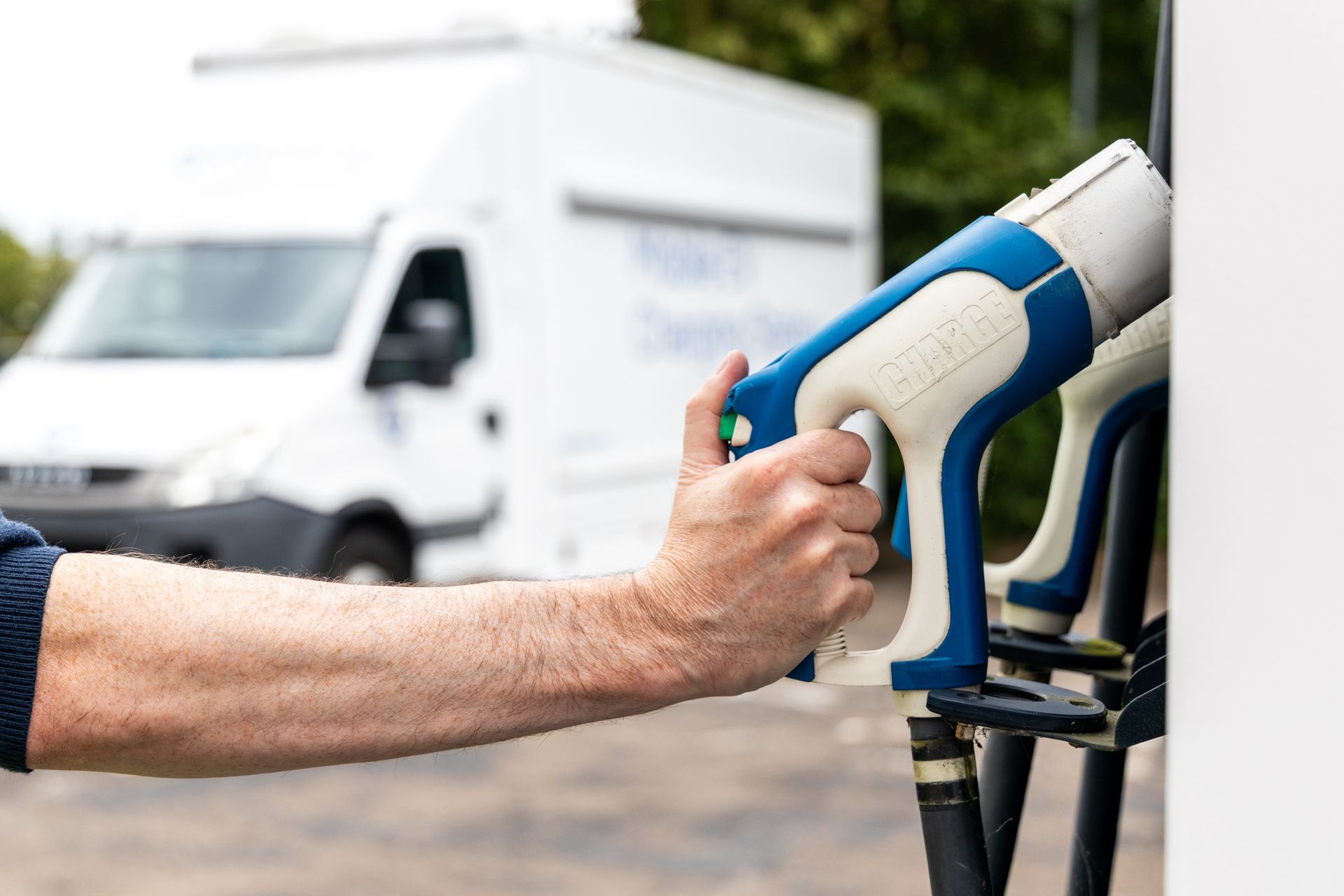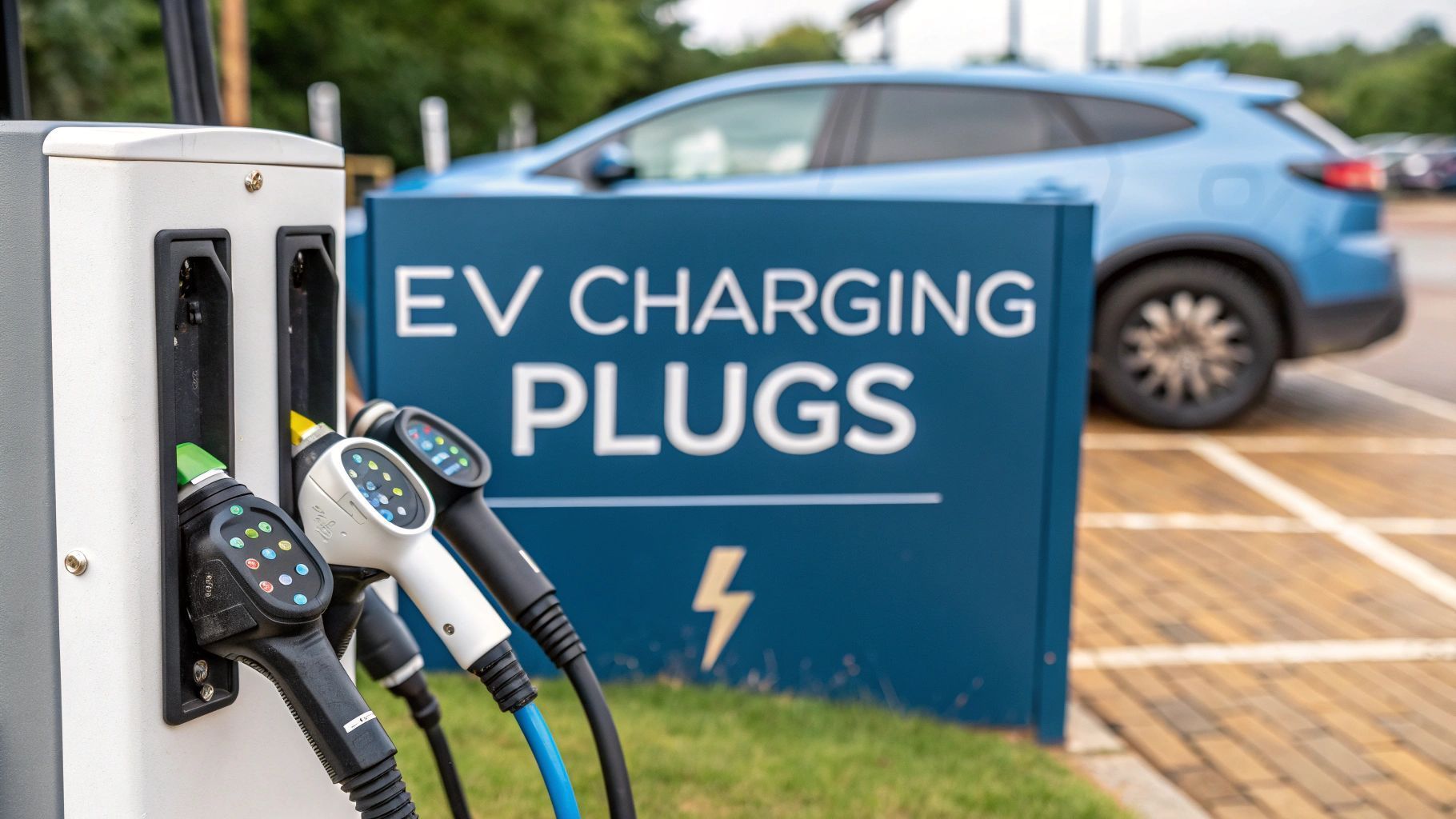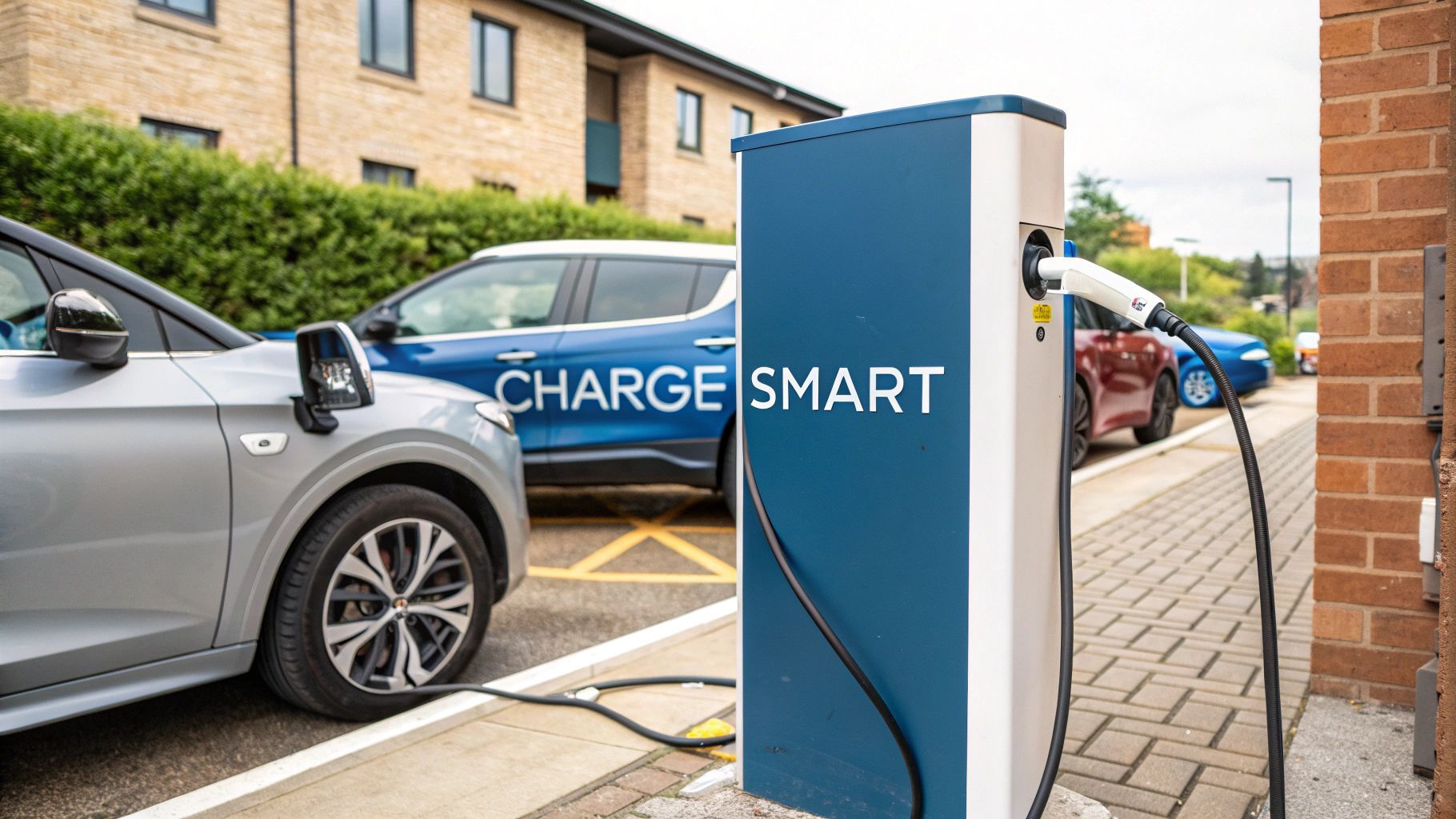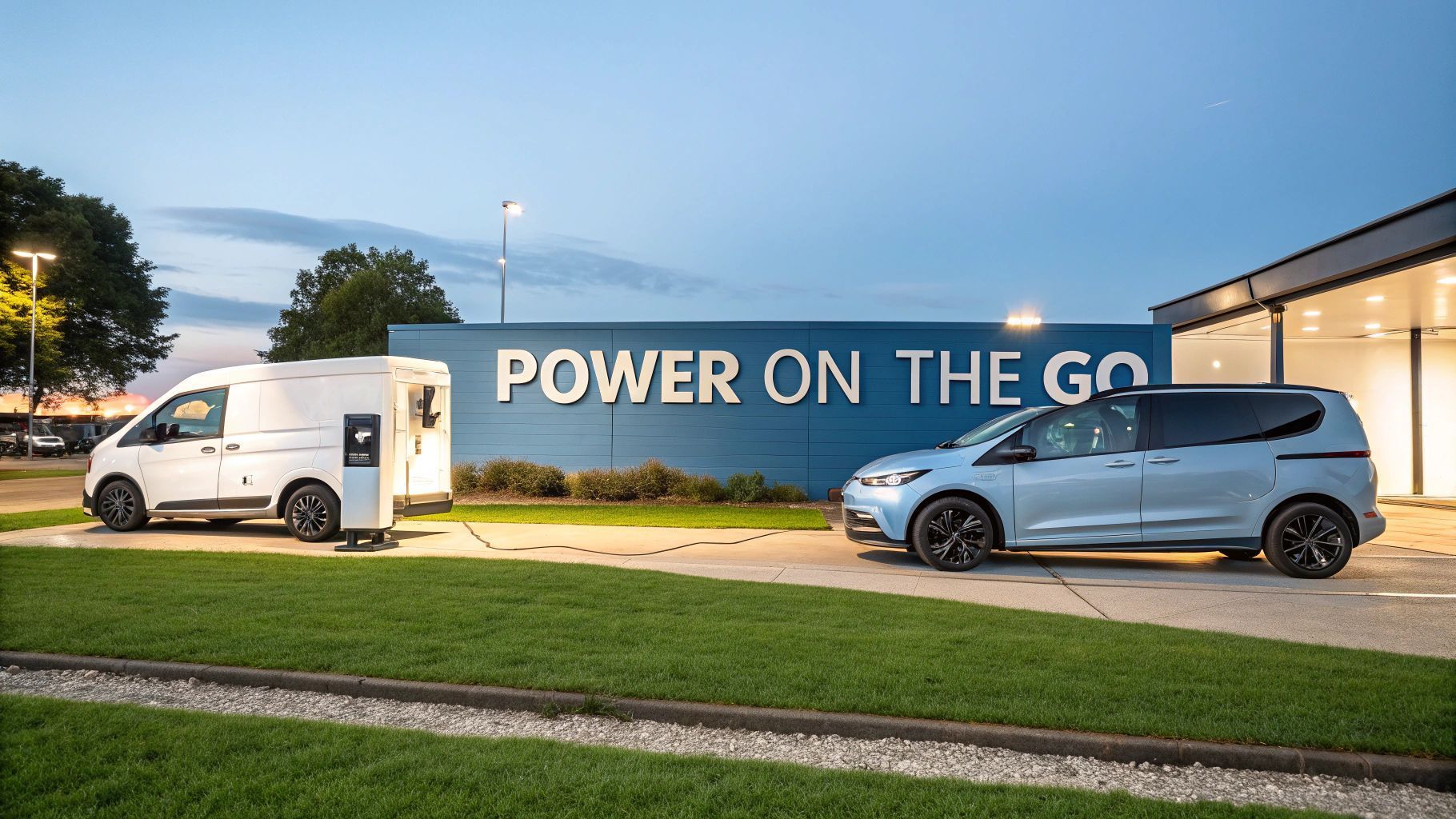Profit with a Portable Charging station for Electric Cars
Think of it as a jerrycan for the electric age. That’s the simplest way to picture a portable charging station for electric cars , a piece of kit designed to rescue drivers from the dreaded ‘range anxiety’. But this technology is more than just a convenience—it's a serious business opportunity, turning a stranded motorist into a reliable revenue stream.
The New Frontier in Roadside Revenue
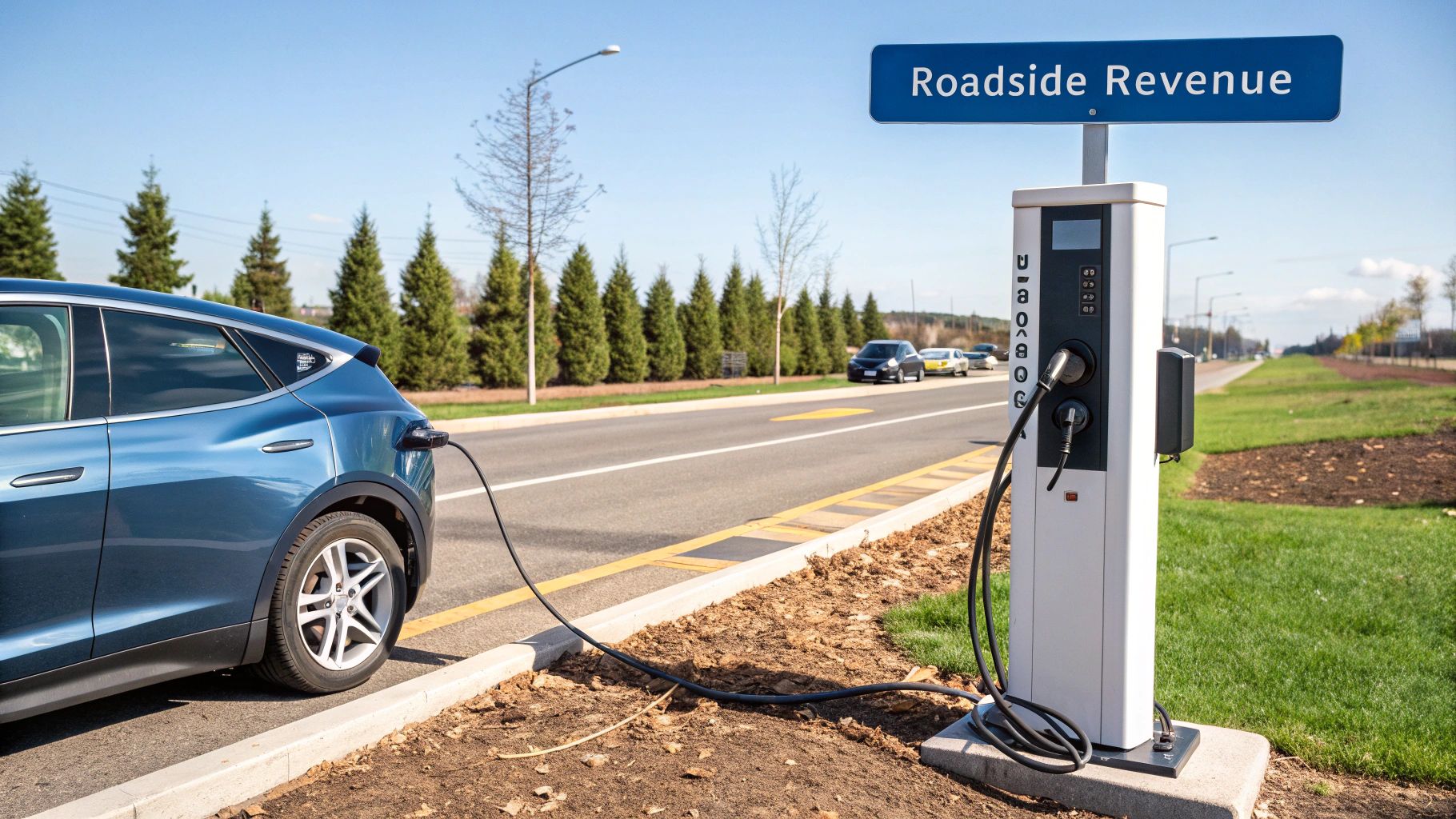
The rapid switch to electric vehicles across the UK is creating huge demand for charging solutions that aren't bolted to the ground. Whilst the fixed charging network is certainly growing, it just cannot cover every roadside breakdown, remote location, or temporary event. This gap in the market is a golden opportunity for forward-thinking businesses.
For an operator a portable EV charger is a mobile asset that generates high-margin revenue on demand. The business model is refreshingly simple: you deliver power where it's needed most and charge a premium for the urgent, convenient service.
Capitalising on a Growing Market
The demand is being fuelled by the sheer number of EVs hitting the roads. And despite all the investment in infrastructure, gaps are inevitable. Even with a fast-growing network of fixed points, drivers will always get caught short from time to time.
The UK's public charging network is scaling up quickly to keep pace. By May 2025 there were 80,998 public charging devices dotted across the country—a massive 30% increase in just twelve months. This growth is vital as the UK heads towards its goal of ending new petrol and diesel car sales but it also shines a light on the need for a safety net when fixed chargers are busy, broken, or simply not there. You can get more detail on the growth of the UK's EV infrastructure from EVision.
This is precisely where the mobile charging operator comes in. You’re not trying to compete with the fixed network; you’re complementing it, filling the holes that static infrastructure can never completely plug.
Turning Anxiety into Profit
The value you offer is incredibly clear. When an EV driver is stranded, their only concern is getting moving again, quickly and safely. The cost of an emergency charge becomes secondary to the solution you're providing right there and then. This dynamic allows operators to set their prices for maximum profitability.
Just think about the advantages for a mobile charging business:
- High-Margin Services: Emergency call-outs naturally command premium pricing, typically a call-out fee plus a per-kWh rate.
- Low Overheads: Compared to digging up roads to install fixed infrastructure, a mobile unit has a much lower barrier to entry and fewer ongoing costs.
- Operational Flexibility: You can go where the demand is, whether that's a busy motorway, a city centre, or a rural 'charging desert'.
- Diverse Revenue Streams: It's not just about emergencies. Operators can serve commercial fleets, taxi ranks, and even provide temporary power at events.
Mobile charging is a business-in-a-box for a growing, high-demand market. It solves a real-world problem for EV drivers and provides a clear path to profitability for the operator.
Ultimately a portable charging station lets an operator sell peace of mind. For roadside assistance firms, fleet managers, and independent entrepreneurs alike, this represents an exciting new frontier in roadside revenue—turning a modern headache into a profitable business.
How Portable EV Chargers Actually Work
To see the real business potential in portable EV charging, you first need to get your head around how the technology actually works. Forget the complex engineering diagrams; the core ideas are surprisingly simple, especially when you think of it like a jerrycan for an electric car.
At its heart a portable EV charger is just a big, clever battery on wheels. The best way to think about its battery capacity, measured in kilowatt-hours ( kWh ), is as the size of its "fuel tank". A unit with a larger kWh capacity holds more energy, meaning it can deliver more charge or help out more drivers before it needs topping up itself.
But the "fuel tank" is only half the picture. The other crucial number to watch is the power output, measured in kilowatts ( kW ). This is basically the speed of the pump. A higher kW rating means the unit can push energy into a stranded EV much faster, getting your customer moving again in less time and freeing you up for the next job.
AC vs DC: The Crucial Difference
When it comes to charging an EV, not all power is the same. The difference between Alternating Current (AC) and Direct Current (DC) is absolutely vital for any mobile charging operator because it directly shapes your service speed and efficiency.
An EV’s battery can only store DC power. Because the electricity grid supplies AC power, every EV has a small onboard converter to switch AC to DC. This internal converter is fairly slow, which is why charging from a typical home wall box can take hours.
A DC portable rapid charger works differently. It completely bypasses the car's slow internal converter and feeds DC power straight to the battery. This is the secret to providing a fast, on-the-road service. Whilst a basic AC portable unit might offer a slow trickle charge, a DC unit can add a meaningful amount of range in minutes, not hours.
For a mobile charging business, DC charging isn't just a feature; it's the foundation of your entire service. It’s what lets you deliver a valuable, time-sensitive solution that customers will happily pay a premium for.
This direct-to-battery approach is what makes a mobile service genuinely rapid. A typical roadside assistance call might only need an extra 15-20 miles of range —just enough to get the driver safely to the nearest fixed charging point. With a DC portable unit, you can deliver that in as little as 10-15 minutes .
Types of Mobile Charging Units
Portable EV chargers are not a one-size-fits-all product. The hardware you invest in will depend entirely on your business model, whether you're running a nimble emergency response service or providing large-scale power for events. Knowing the main types of units is the first step in picking the right tool for the job.
The main categories you'll come across include:
- Compact Van-Mounted Systems: These are the workhorses of the roadside assistance world. They're small enough to be permanently fitted into a standard commercial van, like a Ford Transit, without taking up too much space for other tools. They usually offer rapid DC charging speeds, perfect for those quick emergency top-ups.
- Larger Trailer-Based Solutions: When you need more serious power, trailer-mounted units are the answer. These can house much bigger battery capacities (kWh) and deliver ultra-rapid charging speeds (kW), making them ideal for powering multiple vehicles at an event, a construction site, or a temporary fleet depot where grid access is a problem.
- Standalone Wheeled Units: Sometimes called 'trolley' or 'cart' chargers, these smaller units offer ultimate flexibility. They can be wheeled around a car park, workshop, or showroom to charge vehicles without needing to move the cars themselves. It’s a convenient solution for dealerships or fleet managers.
Each of these systems is built for a specific job. A roadside recovery firm would naturally lean towards a van-mounted unit for its speed and mobility. An events company, on the other hand, would opt for a trailer to guarantee a reliable power supply all day. The type of portable charging station you choose will ultimately define the services you can offer and the customers you can serve.
Building Your Mobile Charging Business Model
So you’ve got a portable EV charging station. It's more than just a piece of kit; it's a business on wheels, ready to roll. But how do you actually turn that mobile power into a reliable income stream? It all comes down to finding the right business model for your goals and turning a clever concept into a profitable reality.
There are a few proven ways to make money with mobile charging and each one serves a different kind of customer with its own unique rewards. From high-stakes roadside rescues to planned corporate services, that portable unit is your key to unlocking new opportunities in the booming EV market.
The beauty of it is the flexibility. One day you might be the fourth emergency service for a stranded driver and the next you’re providing the essential spark for a local festival.
The Emergency Call-Out Premium
The most straightforward—and often most profitable—model is the emergency roadside call-out. Think of it as the 21st-century version of bringing someone a can of petrol. When an EV driver runs out of charge, they’re not just inconvenienced; they are completely stuck. This creates an immediate, urgent need for a solution and people are more than willing to pay a premium for a rapid response that gets them moving again.
This model is so profitable because of how it’s priced. A typical emergency service charge breaks down like this:
- A Standard Call-Out Fee: This covers your time, fuel, and the general wear and tear on your vehicle just for heading out to the customer. It’s charged no matter how much energy you deliver.
- A Per-kWh Rate: On top of the call-out fee, you charge for the electricity itself. This rate is usually set much higher than what you’d pay at home or a public charger, reflecting the convenience and urgency of the service.
The margins here can be really strong. You’re not just selling electricity; you're selling an immediate fix to a very stressful problem.
Scheduled Contracts for Fleet Operators
Another incredibly reliable revenue stream is setting up contracts with businesses running EV fleets. Think of delivery companies, taxi firms, and even local councils—they all depend on their vehicles being charged and ready to go every single day. A mobile charging service offers them a solution that's both flexible and surprisingly cost-effective.
Instead of sinking huge amounts of cash into fixed charging infrastructure at their depots, which can be a slow and expensive process, fleet managers can simply hire your service. You can top up their vehicles overnight or during downtime, giving you predictable, recurring income whilst the fleet stays on the road without a massive capital outlay. It's a win-win.
Powering Events and Temporary Sites
Beyond the day-to-day, there’s a big market for providing temporary power where the grid simply can't reach. Festivals, outdoor markets, construction sites, and corporate events all need power for a short time and a portable EV charger is the perfect tool for the job.
With this model, you'd typically charge a day rate to hire the unit, plus an extra fee for the energy consumed. This B2B approach can be extremely lucrative. Event organisers need a power source they can count on and are prepared to pay for a professional service that ensures everything runs without a hitch. If you're looking to build a solid foundation, check out these expert tips on starting an equipment rental business , as many of the principles apply here too.
The infographic below gives you a clearer idea of how these different services can stack up in terms of average revenue.
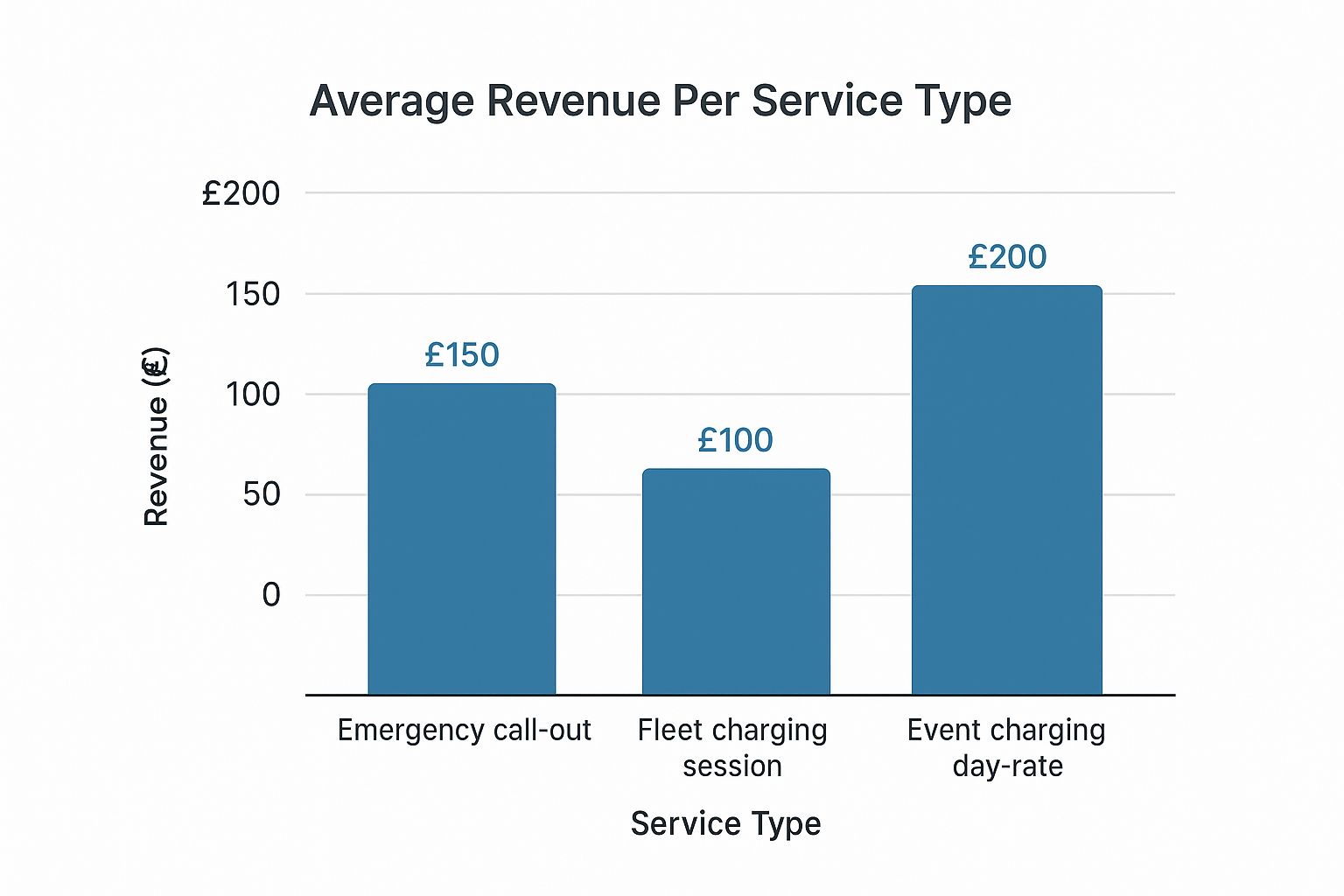
As you can see, each model presents a strong case for revenue, with event hire and emergency call-outs often bringing in the highest returns per job.
To help you decide which path might be right for you, we've broken down the different business models, their target customers, and potential profit margins.
Potential Revenue Models for Mobile EV Charging
| Business Model | Target Customer | Example Pricing Structure | Estimated Profit Margin |
|---|---|---|---|
| Emergency Roadside Assistance | Stranded individual EV drivers, breakdown services (AA, RAC). | Flat call-out fee (£75-£150) + premium per-kWh rate (£1.50+). | High (60-75%) |
| Scheduled Fleet Charging | Delivery companies, taxi firms, local authorities, car rental agencies. | Monthly retainer + discounted per-kWh rate, or a simple nightly/weekly hire fee. | Medium to High (40-60%) |
| Event & Site Power Hire | Festivals, outdoor markets, film sets, construction sites. | Daily/weekly hire rate (£200-£500) + cost of energy consumed. | High (50-70%) |
| "Charging as a Service" Pop-Ups | Shoppers at retail parks, visitors at tourist spots without chargers. | Per-kWh rate slightly above public rapid chargers, with a small connection fee. | Medium (30-50%) |
Choosing the right model—or even a mix of them—depends on your local market and the kind of service you want to provide.
Calculating Your Profitability
To really succeed, you need to get your numbers straight—that means understanding both your income and your outgoings. Operational costs are a key part of the equation and will include things like vehicle insurance, fuel or energy for your service vehicle, and maintenance for both the van and the charger.
Luckily these costs are often pretty modest compared to what you can earn. And ironically the massive growth in fixed charging points is actually helping your business case. By the end of September 2025 the UK's public EV charging network had grown to 86,021 devices , a 22% increase in just one year. But even this rapid expansion leaves gaps—geographical dead zones and periods of high demand—that mobile charging is perfectly placed to fill.
By combining different models—say, offering emergency call-outs during the day and fulfilling a fleet contract overnight—an operator can maximise the use of their asset and build a resilient, highly profitable business.
By carefully picking your target market and pricing your services right, a portable EV charger can deliver a strong and swift return on your investment. If you want to dive deeper into the figures, you can learn more about the economics of mobile EV charging in our article.
Where to Find Your Most Profitable Customers
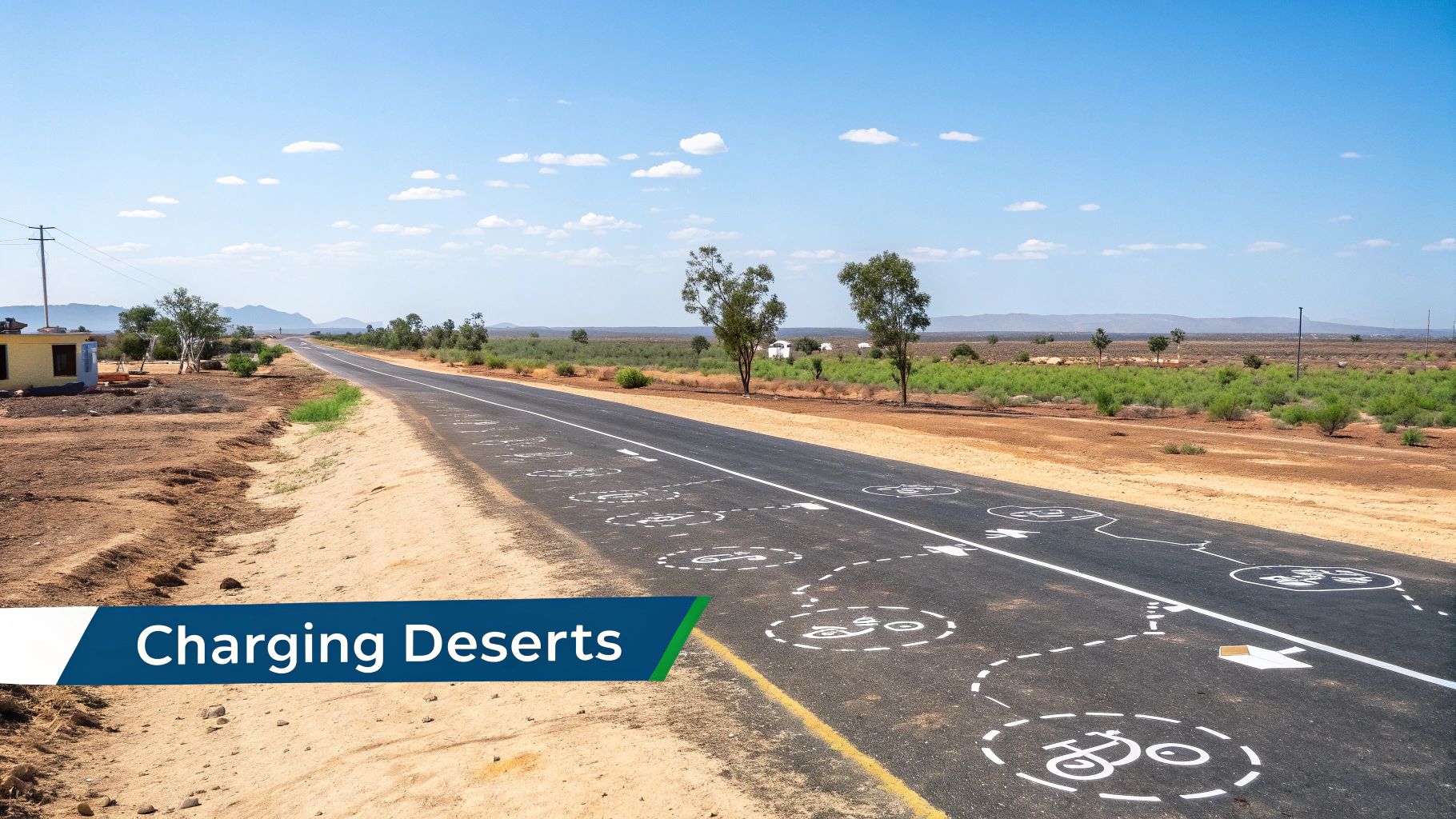
Success in the mobile charging game boils down to one simple rule: be in the right place at the right time. A portable charging station for electric cars is an incredible asset but its profitability is directly tied to your ability to pinpoint where demand is highest and service is most needed. This means looking beyond the obvious to find the specific gaps in the UK’s charging infrastructure that you can fill.
It’s crucial to understand that not all EV drivers are your primary customers. Your most profitable opportunities are with those who have an urgent, time-sensitive need for power. By focusing on these high-value scenarios, you can turn your mobile unit from a simple piece of hardware into a premium, on-demand service.
Capitalising on Charging Deserts
Whilst the national network of fixed chargers is growing, its distribution is far from even. This creates "charging deserts"—areas where the number of EVs far outstrips the available public charging points. These are your goldmines. Rural and suburban locations are often the most underserved, forcing local EV drivers to rely solely on home charging or make long detours to find a public plug.
This uneven spread presents a huge opportunity for a mobile operator. Regional disparities in the UK's charging infrastructure are stark. As of July 2025 Greater London leads with over 25,502 public EV charging devices —that’s around 30% of the UK's total and more than double any other region. In sharp contrast, Northern Ireland has just 707 devices . You can dive deeper into the regional breakdown of UK charging points from Uswitch.
This gap highlights exactly where a mobile charging service can become an essential local utility, providing top-ups for residents and peace of mind for visitors. By positioning your service in these areas, you solve a genuine problem. You become the go-to solution for anyone caught short, turning a local infrastructure weakness into your business's greatest strength.
High-Value Commercial Partnerships
Whilst individual emergency call-outs are lucrative, your most reliable income will often come from building relationships with other businesses. These B2B partnerships provide steady, predictable revenue and position you as a critical part of their day-to-day operations.
Think about these high-potential customer groups:
- Taxi and Ride-Sharing Fleets: For a taxi or private hire driver, time off the road is money lost. When their battery runs low mid-shift, they can’t afford to wait in a queue at a public charger. A mobile top-up service that comes directly to them is invaluable, getting them back to earning in minutes.
- Roadside Assistance Services: Partnering with breakdown organisations like the AA and RAC is a powerful move. You become their specialised EV support, handling the growing number of "out of charge" calls they receive. This provides a constant stream of qualified leads.
- Commercial Fleets: Delivery companies, logistics firms, and local councils are all electrifying their fleets. A portable charging station for electric cars can provide essential overnight charging at depots without fixed infrastructure or offer emergency power to vehicles out on their routes.
The most profitable customers aren't just individual drivers in distress; they are businesses whose own revenue depends on their vehicles staying mobile. Your service directly supports their bottom line.
Niche Markets Far from the Grid
Finally, think beyond the roadside. Many industries and events operate in temporary or remote locations where permanent power is either unavailable or impractical. Your mobile charging unit is the perfect solution for these off-grid power needs, opening up a diverse range of profitable niche markets.
Imagine supplying power for:
- Film and Television Production: Film sets are often located in remote countryside spots. Your mobile unit can power everything from camera equipment to the crew's electric vehicles, providing a quiet and emissions-free alternative to noisy diesel generators.
- Outdoor Events and Festivals: From food festivals in a park to music events in a field, temporary gatherings need reliable power. You can offer charging for vendors, staff, and even attendees' vehicles, establishing yourself as a key event supplier.
Each of these scenarios presents a clear problem that your mobile charging service can solve efficiently and profitably. By zeroing in on these specific customer segments, you can direct your efforts where they will generate the greatest return and build a robust, multi-faceted business.
Choosing the Right Portable Charging Solution
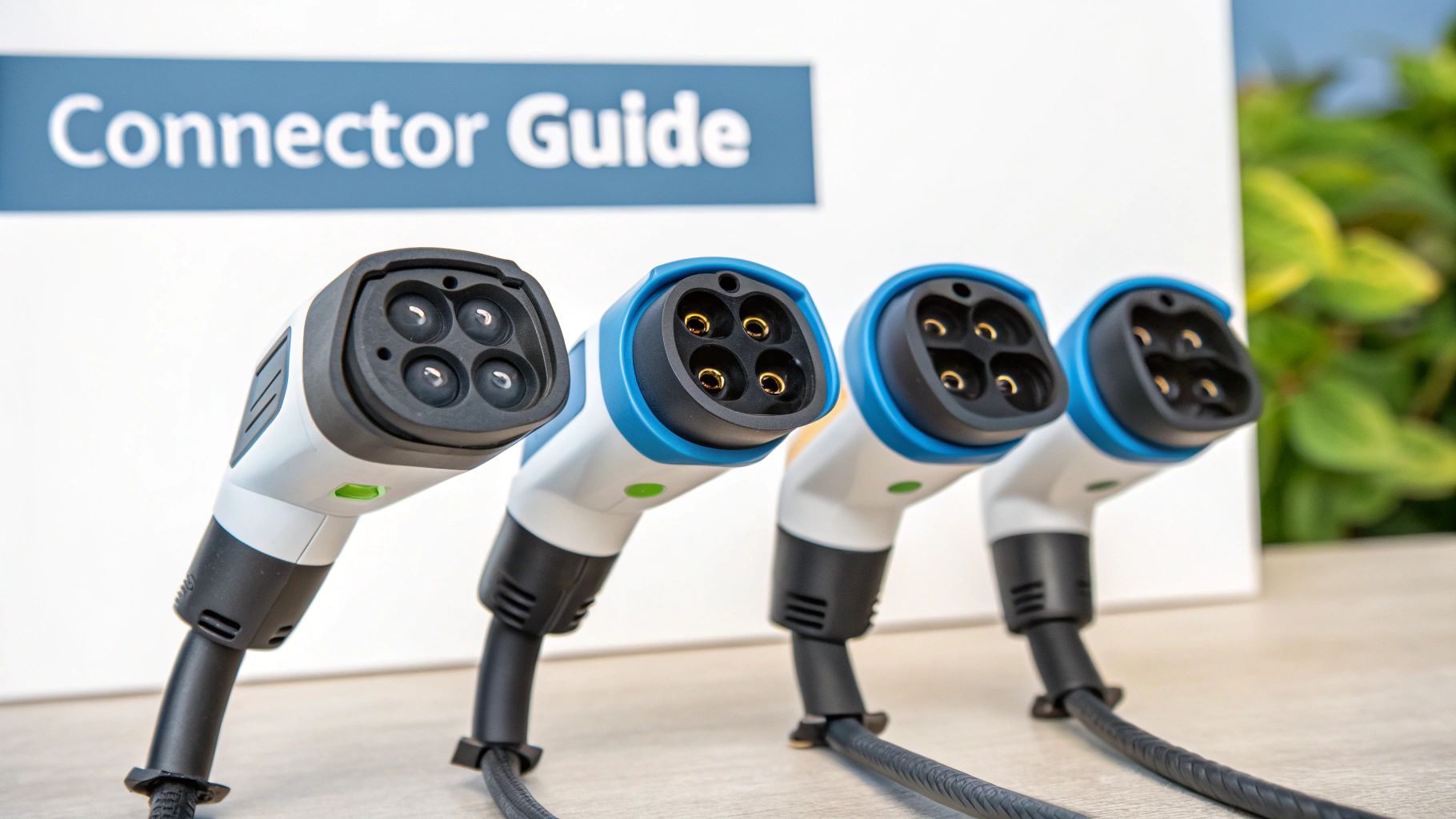
Picking the right portable charging station for electric cars is probably the single most important decision you'll make for your new venture. The hardware you choose directly impacts your service's reliability, how quickly you can get customers back on the road and ultimately, your bottom line. This isn't just about finding the biggest battery; it's about matching the right tech to your specific business model.
A high-quality portable unit is a robust, road-ready tool built for daily use in all weathers. A cheaper, flimsy alternative might look good on paper but it quickly turns into a liability when it fails on a call-out. To make a smart investment that pays for itself quickly, you need to get to grips with the technical details that actually matter in the real world.
That means looking beyond the marketing and digging into everything from the battery chemistry to the specific plugs needed for every EV on UK roads.
Understanding the Core Technology
The heart of any portable charger is its battery and the chemistry inside has a massive say in its safety, lifespan, and performance. You'll mainly come across two types: Lithium-Ion (often NMC) and Lithium Iron Phosphate (LFP). Whilst both get the job done, LFP is quickly becoming the go-to choice for commercial mobile charging.
So, why should an operator care? LFP chemistry is famed for its excellent thermal stability, which makes it far less likely to overheat—a critical safety feature for a device you'll be using day in, day out. On top of that, LFP batteries typically offer a much longer cycle life. This means they can be fully charged and discharged 2 to 4 times more than many standard Lithium-Ion versions before their capacity starts to drop. That kind of durability translates directly into a longer-lasting, more reliable business asset.
Built for the British Road
Let's be honest, a portable charger used for roadside assistance or event hire is going to have a tough life. It’ll be hauled in and out of a van, wheeled over bumpy ground, and left out in our famously unpredictable British weather. A rugged, durable design isn't a nice-to-have; it's an absolute must.
When you're sizing up a unit, look for signs that it's built for proper commercial work:
- Robust Casing: A tough, weather-resistant shell that shields the electronics from rain, dust, and knocks is non-negotiable.
- Industrial-Grade Components: Check for heavy-duty wheels, solid handles, and protected ports that can handle the reality of daily mobile use.
- Smart Cable Management: Well-designed, tethered cables are essential for setting up quickly and stopping expensive connectors from getting damaged or lost.
Think of your portable charging station as a tool of your trade. Investing in a unit with a proven, rugged design is like a mechanic buying a top-quality spanner—it ensures you can do your job properly, every single time.
Ensuring Universal Compatibility
To attract the widest possible customer base, your portable unit needs to be able to charge any EV it comes across. In the UK, that means having the right connectors to cover the entire market. Any professional-grade portable charger should come equipped with the three standard plugs as a minimum.
- CCS (Combined Charging System): This is the go-to standard for DC rapid charging for most European and American EVs, including big names like Volkswagen, BMW, Ford, and Hyundai. You'll be using this one a lot.
- CHAdeMO: You'll find this DC connector on vehicles from Japanese manufacturers, especially the Nissan Leaf and Mitsubishi Outlander PHEV. Whilst it's less common on brand-new models, there are still thousands of them on the road.
- Type 2: This is the standard AC connector across Europe. Whilst DC charging will be your main service, having a Type 2 option gives you valuable flexibility.
A unit offering all three means you never have to turn a customer away, securing every possible bit of revenue. If you're looking for equipment that ticks these boxes, you can explore a range of professional-grade ZAPME mobile EV chargers here.
A Checklist for Your Investment
Before you sign on the dotted line, you need to ask any potential supplier the right questions. Their answers will tell you a lot about the quality of the product and the support you can expect down the line. Treat it like you're interviewing the most important new member of your team.
Use this simple checklist as your guide:
- Warranty and Support: How long is the warranty and what exactly does it cover? Is there a UK-based support team you can actually speak to if things go wrong?
- Software and Connectivity: Does the unit have smart features like remote monitoring or built-in payment systems? How are software updates managed?
- Training and Onboarding: Will they show you how to use the unit safely and get the most out of it?
- Proven Track Record: Can they point you to case studies or testimonials from other mobile charging businesses already using their kit?
Asking these tough questions upfront will help you choose a portable charging station for electric cars that isn't just a piece of hardware but a dependable partner in your business's success.
Powering Your Mobile Charging Venture
A portable charging station for electric cars is much more than just a piece of kit; it's a business-in-a-box for a market that's not just growing but crying out for solutions. The real opportunity here is its flexibility and the surprisingly low barrier to entry when you compare it to the cost and complexity of installing fixed infrastructure. Mobile charging offers a clear path to profit and it's available right now.
Think of it less as a simple business venture and more as a vital service. You're making electric vehicle ownership a practical reality for everyone, everywhere. It’s about bridging the gaps left by the static charging network, turning the headache of a flat battery into a premium, on-demand revenue stream for you.
Launching Your Enterprise
Getting off the ground means investing in the right equipment first. To get your hands on the necessary portable charging stations, exploring various equipment financing solutions can make that initial cost much more digestible. This approach lets you preserve your capital for other parts of the business whilst putting your new assets to work straight away.
Your profitability will really hinge on how well you understand your running costs versus the revenue from each call-out. To price your services effectively, you need to factor in more than just the electricity you’re selling. You also have to account for your time, vehicle costs, and the premium nature of an on-demand service. Getting this right starts with a solid grasp of energy measurement, so learning how to calculate a kilowatt-hour is essential for building a pricing model that’s both fair to customers and profitable for you.
Looking ahead, the technology is only going to get better. It's easy to imagine future portable units featuring vehicle-to-grid (V2G) capabilities. This would allow them to not only charge EVs but also feed power back into the grid during peak times, opening up yet another potential revenue stream.
This guide was designed to give you a comprehensive overview, starting from the ground up. With this knowledge in your back pocket, you should feel ready and confident enough to take the next steps and launch your own successful mobile charging enterprise in this exciting and rapidly expanding sector.
Got Questions? We’ve Got Answers.
Diving into the world of mobile EV charging is exciting but it’s natural to have a few questions. From the initial investment to the nuts and bolts of a roadside call-out, we’ve put together some straightforward answers to the queries we hear most often.
Getting these details right is the first step in building a solid business plan and launching a service that’s built to last. Let’s get into it.
How Much Does a Commercial Portable EV Charger Cost?
The investment for a professional, commercial-grade portable charging station for electric cars can vary quite a bit. You can get started with a solid, entry-level DC rapid charger for somewhere in the region of £20,000 to £30,000 .
If you're looking for something with a bit more punch—like an ultra-rapid unit or one with a much larger integrated battery—you could be looking at £50,000 or more. The price tag isn't just about charging speed; it reflects the unit's durability, built-in safety features, and the quality of the manufacturer's warranty and support.
What Are the Main Legal and Insurance Requirements in the UK?
Operating a mobile charging business in the UK means getting the right legal and insurance cover in place to protect yourself and your customers. It’s not complicated but it is essential.
Here’s what you’ll need:
- Public Liability Insurance: This is non-negotiable. It covers you if someone claims they were injured or their property was damaged whilst you were providing your service.
- Specialist Vehicle Insurance: Your standard van insurance won’t cut it. You’re carrying and operating high-voltage equipment, so you’ll need a specific policy that covers this commercial risk.
- Electrical Safety Standards: All your gear must be certified, and you must operate in line with UK electrical safety regulations. This ensures every charge is delivered safely, every single time.
How Long Does It Take to Give an EV a Useful Charge?
This really comes down to your charger’s power output (measured in kW) and the car you’re charging. Remember, an emergency call-out isn't about filling the battery to 100%. The goal is to give the driver enough juice to comfortably reach the nearest fixed charging point.
With a professional DC rapid charger (typically 20-50kW ), you can add 20-30 miles of range in just 15-20 minutes . That’s more than enough to get a stranded customer out of a tight spot and safely on their way.
Ready to power the future of roadside assistance? ZAPME offers a complete range of rugged, reliable and road-ready mobile EV charging solutions designed and built in the UK. Discover the right equipment to launch your business by visiting us at https://www.zapme.biz.

